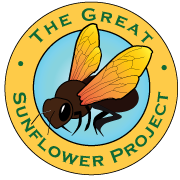Native bees need nectar (for energy) and pollen (for protein). The following are some guidelines to follow when creating foraging habitat for native bees.
| What flowers should I plant?. Flowers are food resources. Patches of foraging habitat can be created in many different locations, such as field edges, stream corridors, backyards, school grounds, golf courses and city parks. Even a small area planted with the right flowers will be beneficial, because each patch will add to the mosaic of habitat available to bees. |
|
• Incorporate a succession of flowers in order to provide bloom throughout the entire growing season. A diverse selection of flowering plants that bloom in succession will support a more diverse community of pollinators.
• Choose species that are easy to plant and establish. Your local chapter of the Native Plant Society and native plant nurseries can give advice on local plant species. Here is a general list of good bee plants. For California, there is a list of urban bee plants.
• Use local native plant species. Native plants are more likely to attract native bee pollinators than are exotic flowers. You may supplement natives with heirloom varieties of herbs and perennials. Do not plant invasive species.
• Choose flowers with a variety of shapes and colors to attract a wide variety of bees. Different bee species have mouthparts adapted to different shapes of flowers; short-tongued bees can drink only from open flowers such as asters or daisies, while long-tongued bees can reach the high-energy nectar in deep flowers such as bluebells or lupines. Flower colors that known to attract bees are blue, purple, violet, white, and yellow.
• Plant flowers in clumps. Flowers clustered into clumps of one species will attract more pollinators than individual plants scattered through the habitat. Where space allows, make the clumps four feet or more in diameter.
Land management considerations. You can help maintain healthy populations of bees by making slight adjustments in land management practices to ensure habitat is provided throughout the year. In order to maximize foraging opportunities, avoid maintenance treatments while plants are in flower, and allow plants to bolt before tilling. Never burn, graze or mow an entire area at once. This will allow for recolonization of the treated area from unaffected areas, an important factor in the recovery of pollinator populations.
Pesticides. Do not use pesticides unless absolutely necessary; insecticides can kill bees, and herbicides can kill their food sources. If they must be used, pesticides should be applied with careful timing and targeted spraying methods in order to minimize impacts on pollinators.
Nest sites.
Solitary ground nesting bees
• Where possible keep bare or partially vegetated ground; these bees need direct access to the soil surface to excavate and access their nests. Clear the vegetation from small patches of level or sloping ground and gently compact the soil surface. These patches should be well drained and in an open, sunny place. Ground-nesting bees seldom nest in rich soils, so poor quality sandy or loamy soils may provide fine sites.
• Do not put thick layers of mulch or landscape fabric over potential nesting sites. These barriers can prevent bees from burrowing into the soil
• Create sand pits and piles. In a sunny, well-drained spot, fill a pit about 2 feet deep with a mixture of fine-grained sand and loam. Where soils do not drain well, a make a pile of the sand/loam mixture instead – or fill a planter with the mixture.
Solitary wood (or tunnel) nesting bees
• Leave snags or dead tree limbs. An arborist can advise on whether a snag is really a hazard; if you can leave it, it may provide excellent nesting habitat.
• Cut the ends off pithy-centered stems on plants such as elderberry, boxelder, raspberry, or dogwood. Bees will nest in holes they dig in the soft pith.
• Supplement your garden with nest blocks.
Bumble bees
Bumblebees are social, and they nest in small cavities, such as grass tussocks, banks with loose soil, and abandoned rodent nests.
• Leave patches of tall, overgrown grasses on warm south-facing slopes for bumblebees to find rodent burrows in which to nest.
• Supplement these patches with nest boxes. Nesting boxes for bumble bees tend to be less successful.
Make sure not to introduce non-local bees, even if your source claims they are a native species. Introduced bees can be detrimental to native populations. If you provide habitat, locally resident bees will find it and their populations will be strengthened.
Based on materials from the Xerces Society for Invertebrate Conservation
